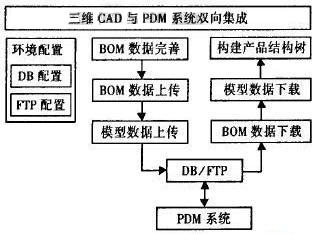Research and Application of Two-way Integration Technology of 3D CAD and PDM System
It can be seen that the integration of CAX and PDM systems has become the primary task of enterprise informationization. The two-way integration of 3D CAD and PDM system is the most demanding and difficult part of the specific implementation. To solve this problem, this paper introduces the principle and key implementation technology of two-way integration of 3D CAD and PDM system.
1 Application integration mode
Integration is based on information technology and application aggregation in a collaborative work, which includes management and control of functional interaction, information sharing and data communication. For the integration level between CAD PDM, it is divided into the following three modes.
1. 1 Application Packaging Mode
The application encapsulation mode integrates all CAD applications so that different applications can share information, while the PDM system effectively manages the feature data and data files generated by different applications. When the PDM system encapsulates the CAD application, the corresponding CAD system can be directly activated in the graphic file of the PDM system, and the corresponding graphic file is displayed in the system. Conversely, in the CAD system, the PDM system can also be directly used to perform corresponding data management operations, but the PDM system is not allowed to manage the data inside the file. Generally, the encapsulation mode is used for the integration of the PDM system with the 2D CAD software, and the degree of automation is low, but the implementation workload is small and easy to implement.
1. 2 interface exchange mode
The interface exchange mode is an API function programming interface program provided by CAD, which acquires the product structure tree information in the CAD assembly model and the assembly constraint relationship of the components. Information such as product structure and associated documents are submitted to the PDM database through data exchange. In addition, the PDM API function is used to extract the latest product structure tree information in the PDM database to update the assembly model in the CAD system, so that the data is asynchronous and consistent. The interface mode is a higher level integration mode than the package mode, and the degree of automation is higher. Generally suitable for the integration of PDM systems with 3D CAD software. However, the development of the interface mode is heavy and the requirements for developers are high.
1. 3 tight integration mode
Tight integration mode is an integrated mode in which CAD and PDM systems provide two-way exchange and sharing of all types of data such as product data, feature data and application data. Tight integration always keeps the CAD product assembly relationship consistent with PDM's product structure tree. Tight integration mode is the ideal integration mode, and the integration is quite complex and generally only available to software vendors.
2 system integration overall structure and main functions
This paper adopts the interface exchange mode to realize the bidirectional integration of 3D CAD and PDM system. On the one hand, the product structure information and associated document files are submitted to the PDM system in batches through the CAD system, the product BOM structure is constructed in the PDM system, and the model documents are associated; on the other hand, the relevant product BOM structure information and associated documents are directly read from the PDM system to update. Model information in CAD enables bidirectional asynchronous exchange of data between 3D CAD and PDM systems. The overall structure of the two-way CAD and PDM system bidirectional integration is shown in Figure 1.

Figure 1 Two-way integrated structure of 3D CAD and PDM system
In the product design process, the data and leaf-set documents generated by the enterprise are generally stored in the server database and FTP. From the perspective of the flow of data and documents and the function of system bidirectional integration, the two-way integration of 3D CAD and PDM system mainly includes two functions of data uploading and data downloading, as shown in Figure 2. The data uploading part mainly includes temporary data processing, BOM data uploading and model document data uploading: the data downloading part mainly includes BOM data downloading, model document data downloading and building product structure tree in CAD.

Figure 2 Two-way integration of 3D CAD and PDM systems
Next page